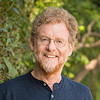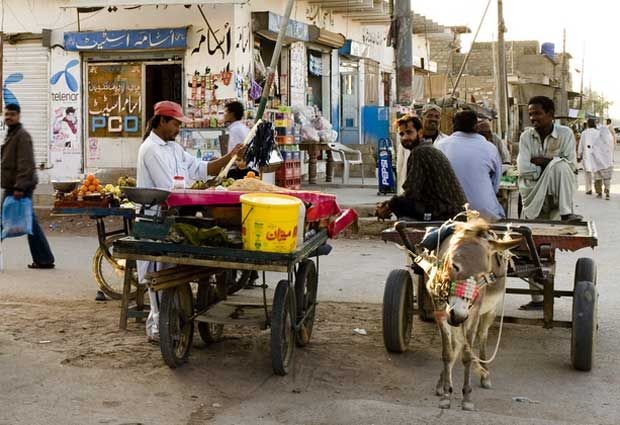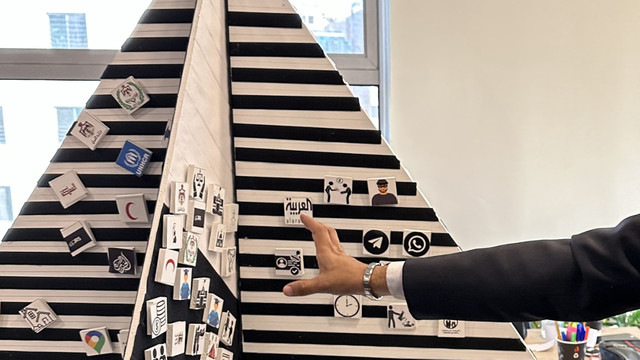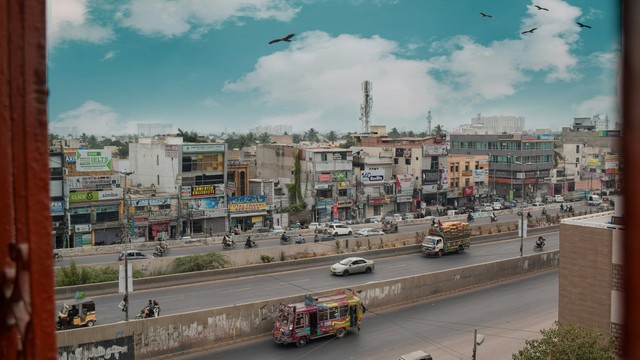Can we change the goals of development without changing the implementers?
The latest draft of the Sustainable Development Goals and targets contains a stunning list of commitments, but fails to address how we will achieve them.


Street scene, Karachi, Pakistan. (Photo: Copyright Fareena Chanda)
This blog refers to what was on 9 July the latest draft (PDF) of the Sustainable Development Goals and targets – not the most recent draft.
We have a new draft on the proposed Sustainable Development Goals (SDGs) and targets for the post 2015 development agenda. The draft is radical in what it commits governments and international agencies to achieve. But it seems to think that radical change can be achieved without changing existing institutional and governance structures.
As with previous drafts and discussions, it is difficult to assess how useful or influential it will be. Most of those who comment on the SDGs come with a particular theme they want included or strengthened that relates to their interest – for instance does it pay sufficient attention to biodiversity or water resource management or rural development. I come to this with a concern that urban issues get adequate coverage – and the SDGs include a goal and some targets for cities and human settlements. I also have a concern, but also that (rural and urban) poverty and climate change adaptation and mitigation get the attention they need. It is difficult not to feel a little sorry for those engaged in the drafting as they receive so many recommendations.
The new draft starts well. “Poverty eradication is the greatest global challenge facing the world today and an indispensable requirement for sustainable development.” It is also good to see the text recognising at the outset the need to promote sustainable patterns of consumption and production and reaffirming that climate change is one of the greatest challenges of our time.
But it is a bit depressing to have the long list of international declarations and programmes of action that “we reaffirm our commitment to fully implement” because most of these contained commitments to goals and targets that have not been met. And how is development assistance going to manage such a radical shift in effectiveness with so little mention of change to its core institutions?
Universal goals and targets
Unlike the MDGs, in this draft there is the much needed commitment to universal goals and targets for most needs – with everyone to be reached by 2030. So there are the commitments to ending extreme poverty and hunger (and all forms of malnutrition). There is a commitment to universal provision for equal access to all men and women to basic services. Some of these services are specified under different goals and they include universal health care, universal primary and secondary education and universal access to safe and affordable drinking water, adequate sanitation and hygiene, affordable, sustainable and reliable energy services, productive resources and financial services. Also the provision of legal identity for all.
There are commitments to ending preventable deaths for new-bornes, infants and under-fives and ending the epidemics of HIV/AIDS, TB, malaria and neglected tropical diseases (although one wonders why diarrhoeal diseases and acute respiratory infections got left out). There is also a commitment to ending all forms of discrimination against women and girls. There is even a commitment to achieving full and productive employment and decent work for all women and men and a commitment to ensuring universal access to adequate and affordable housing and basic services for all.
But can existing institutions meet these goals and targets?
For anyone working in development, this is a stunning list of commitments. If these really were achieved (and measured with accurate and relevant statistics), it would be an amazing endorsement of the SDGs (and of the MDGs that preceded them). But what is notable about development is how little it has achieved towards many of these goals and targets. The last 40 years are littered with unfulfilled commitments. Yet the SDGs say very little about changing the system. As with the MDGs, the document is very good at stating what needs doing but not how and by whom.
At least in urban areas (where my work has been focused), the universal provision of all the services noted above depends on local governments and on the extent and quality of their relationships with those who lack these services. These include the billion urban dwellers living in informal settlements. It also depends on how urban poor groups are organised and whether they have representative organisations and federations to press for change and to work with local governments. Here we find lots of innovation from the growing number of national federations or networks of slum/shack dwellers and even in over 100 cities funds they set up that are jointly managed with local government. We also have new models of finance that support these federations and networks and their work with local governments – for instance the Urban Poor Fund International and the Asian Coalition for Community Action.
But the SDGs, like the MDGs before them, are obsessed with national plans for this, that and the other. There is so little recognition of what are (at least for urban areas) the two most important actors – local government and those lacking basic services and their organisations. There is lots of discussion of finance but not of finance for these key actors. There are recommendations on the need to develop the capacity of governments but it is for national plans. Accountability gets a small mention – but not the accountability that all international agencies and national and local governments should have to those who lack all the promised basic services.
How will existing structures and institutions have any chance of delivering a commitment to achieving full and productive employment and decent work for all women and men and to ensuring universal access to adequate and affordable housing and basic services for all? Nothing wrong with such goals but where are the changes needed to move towards this?
Great goals, nonsense indicators and weasel words
Much of the language in the SDGs draft is inaccurate or unrealistic. Below are just a few examples.
Mismatches between goals and targets and how they are measured
The US$1.25 a day poverty line is still the measure of extreme poverty when we know that this is far too low a line in so many cities and nations. We know that existing data systems cannot measure who has “safe and affordable drinking water” (they do not measure water quality or record costs) or who has adequate sanitation. However, there is some recognition of the vast data gaps in the goal on Data, Monitoring and Accountability, which states: “by 2020, to increase significantly the availability of high-quality and timely data disaggregated by income, gender, age, race, ethnicity, disability, geographic location….”
Text calling for change is not conducive to change
Somehow the discussion of inequality and of sustainable production and consumption avoids mentioning the rich – and the extent to which it is their lifestyles that are driving climate change. From the perspective of global planetary limits, the biggest sustainable development challenge is reducing greenhouse gas emissions from wealthy nations and wealthy citizens’ lifestyles. Climate change gets a strong emphasis in the introduction but the text is very weak - where are the so-much-needed universal goals and targets for climate change adaptation and mitigation?
In target 16.4, there is mention of the need to increase “inclusive, participatory and representative decision-making at all levels and ensure prior informed consent of indigenous and local communities in decision-making and natural resources management,” but far more than this will be needed to get the universal provision of all the basic services listed before this.
Questionable choice of words
In common with so many declarations, the word ‘sustainable’ gets used a lot (over 70 times) and with different meanings. One of the goals is to promote strong, inclusive and sustainable economic growth and decent work for all. But how can ‘strong’ economic growth fit with planetary limits and how can ‘inclusive’ economic growth be achieved within current economic structures? A commitment to inclusion needs attention to the means by which those who are excluded can become included.
There is one particularly scary sentence: “Facilitate orderly safe and responsible migration and mobility of people including through implementation of planned and managed migration policies.” This sounds like a new version of apartheid where governments determine to where people are allowed to move. Or is this meant to be only for emigration and immigration?
The SDGs need to be much more explicit about the means by which all the commitments are to be achieved and the accountability to those who these commitments are meant to benefit to avoid repeating the mistakes of the MDGs.
This blog was first posted on www.IRF2015.org.
David Satterthwaite is a senior fellow in IIED's Human Settlements Group.



